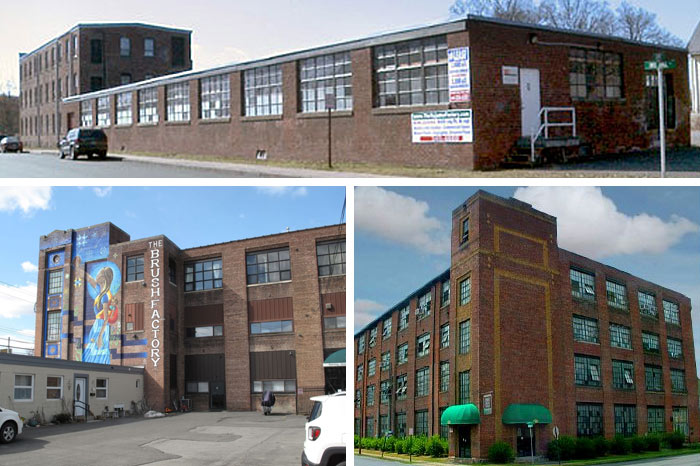
Clockwise from top: The Pajama Factory, Shirt Factory and Brush Factory
Three properties that helped kick off Midtown Kingston’s ongoing transformation have been sold to a developer new to the city’s real estate scene.
Last week, New York City-based Duna Real Estate Group announced that it had purchased three former industrial sites turned artists’ live-work space from developer Mike Piazza.
The properties include the Pajama Factory at 49 Greenkill Ave., the Brush Factory at 107 Greenkill and the Shirt Factory at 77 Cornell St. The $9.75 million deal was led by Duna founder and CEO Hagai Barlev with financing arranged by Max Ralby, Capital Markets Associates and HKS Real Estate Advisors. The deal is Duna’s first foray into the Hudson Valley real estate market. Collectively, the properties total more than 120,000 square feet, the majority of it artists’ live-work space.
Barlev said there was a lot of “deferred maintenance” in the three buildings that needs to be addressed and that he hopes to work with existing tenants so they don’t get priced out of their spaces.
The former factory buildings were redeveloped by Piazza in the early and mid-2000s at a time when the Broadway corridor was struggling with blight and crime. They have since become cornerstones of the Midtown Arts District and the neighborhood’s arts-focused economic redevelopment.
Barlev said this week that he became acquainted with Kingston while traveling with his family from New York City to their second home in Windham. Barlev said he was attracted to the Midtown neighborhood’s vibrant arts scene.
“For me, Midtown represents how the arts and the creative class in general can really drive economic development,” said Barlev. “I saw changes and enthusiasm, there’s really a positive shift going on.”
Barlev’s entry into the city’s real estate game comes at a time of increased concern about the displacement of long-established residents and businesses in the face of soaring values on properties and corresponding increases in rent. Barlev called the issue of gentrification a universal problem based on supply and demand, one that required a careful balancing act between the public and private sphere. Barlev said the purchase of the factory properties was just the beginning of his move into Kingston and that he foresaw future projects including an affordable housing component.
“There’s a fine balance you have to strike between the need for economic development and people wanting to do business, and the needs of others,” said Barlev.

What a great boon to the area! Go Kingston Go!
A very BAD omen for arts community here and the Midtown Arts District. Welcome to the real estate wars. How many times have we heard the same rap from real estate developers?
The usual real estate pattern. Artists act as “pioneers” in down-at-the-dumps urban areas and wind up getting priced out of the market as the neighborhoods gentrify.
Susan, the creation of the Midtown Arts District is part of what made this happen. Welcome to arts-led gentrification
I definitely agree with you, but the Noble administration has done very little work to attract new industries to relocate here that actually employ people. Instead it has focused on building housing for the well-heeled tech workers and a parking garage. RUPCO is the only entity building affordable housing for the community.
Meanwhile apartment rental costs have tripled, any locals that have spent decades saving up and coordinating people to purchase and renovate these spaces into NEW businesses get shafted, just because they don’t have a couple hundred thousand dollars to throw around. I once thought about encouraging my family to move up here, but it’s already unaffordable and the only jobs are stingy and withholding with no benefits or future. The Arts are flat out one of the communities most staggering in terms of wage disparity and insular, nepotistic behavior.
I just hope that they don’t turn these buildings into ugly projects like the Kingstonian Project and that they don’t qualify for Cuomo’s folly giveaway of a PILOT program. You know damned well that the developers foresee making quick fortunes here for the metro marauders. These people displace local businesses and homeowners. They make living here too expensive forcing locals to move on. Gentrification is a threat nationally these days. The City’s leaders and its feckless followers have destroyed everything good about Kingston. They could have used these buildings for desperately needed trade schools and research. Bye bye Kingston.